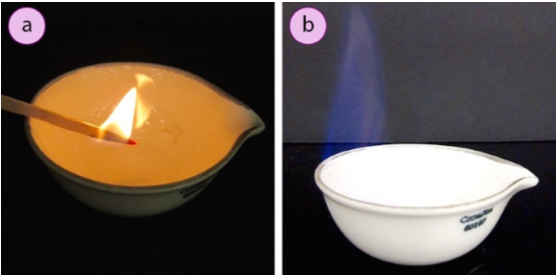1.4A: Methods and Flammability
- Page ID
- 93218
\( \newcommand{\vecs}[1]{\overset { \scriptstyle \rightharpoonup} {\mathbf{#1}} } \)
\( \newcommand{\vecd}[1]{\overset{-\!-\!\rightharpoonup}{\vphantom{a}\smash {#1}}} \)
\( \newcommand{\id}{\mathrm{id}}\) \( \newcommand{\Span}{\mathrm{span}}\)
( \newcommand{\kernel}{\mathrm{null}\,}\) \( \newcommand{\range}{\mathrm{range}\,}\)
\( \newcommand{\RealPart}{\mathrm{Re}}\) \( \newcommand{\ImaginaryPart}{\mathrm{Im}}\)
\( \newcommand{\Argument}{\mathrm{Arg}}\) \( \newcommand{\norm}[1]{\| #1 \|}\)
\( \newcommand{\inner}[2]{\langle #1, #2 \rangle}\)
\( \newcommand{\Span}{\mathrm{span}}\)
\( \newcommand{\id}{\mathrm{id}}\)
\( \newcommand{\Span}{\mathrm{span}}\)
\( \newcommand{\kernel}{\mathrm{null}\,}\)
\( \newcommand{\range}{\mathrm{range}\,}\)
\( \newcommand{\RealPart}{\mathrm{Re}}\)
\( \newcommand{\ImaginaryPart}{\mathrm{Im}}\)
\( \newcommand{\Argument}{\mathrm{Arg}}\)
\( \newcommand{\norm}[1]{\| #1 \|}\)
\( \newcommand{\inner}[2]{\langle #1, #2 \rangle}\)
\( \newcommand{\Span}{\mathrm{span}}\) \( \newcommand{\AA}{\unicode[.8,0]{x212B}}\)
\( \newcommand{\vectorA}[1]{\vec{#1}} % arrow\)
\( \newcommand{\vectorAt}[1]{\vec{\text{#1}}} % arrow\)
\( \newcommand{\vectorB}[1]{\overset { \scriptstyle \rightharpoonup} {\mathbf{#1}} } \)
\( \newcommand{\vectorC}[1]{\textbf{#1}} \)
\( \newcommand{\vectorD}[1]{\overrightarrow{#1}} \)
\( \newcommand{\vectorDt}[1]{\overrightarrow{\text{#1}}} \)
\( \newcommand{\vectE}[1]{\overset{-\!-\!\rightharpoonup}{\vphantom{a}\smash{\mathbf {#1}}}} \)
\( \newcommand{\vecs}[1]{\overset { \scriptstyle \rightharpoonup} {\mathbf{#1}} } \)
\( \newcommand{\vecd}[1]{\overset{-\!-\!\rightharpoonup}{\vphantom{a}\smash {#1}}} \)
\(\newcommand{\avec}{\mathbf a}\) \(\newcommand{\bvec}{\mathbf b}\) \(\newcommand{\cvec}{\mathbf c}\) \(\newcommand{\dvec}{\mathbf d}\) \(\newcommand{\dtil}{\widetilde{\mathbf d}}\) \(\newcommand{\evec}{\mathbf e}\) \(\newcommand{\fvec}{\mathbf f}\) \(\newcommand{\nvec}{\mathbf n}\) \(\newcommand{\pvec}{\mathbf p}\) \(\newcommand{\qvec}{\mathbf q}\) \(\newcommand{\svec}{\mathbf s}\) \(\newcommand{\tvec}{\mathbf t}\) \(\newcommand{\uvec}{\mathbf u}\) \(\newcommand{\vvec}{\mathbf v}\) \(\newcommand{\wvec}{\mathbf w}\) \(\newcommand{\xvec}{\mathbf x}\) \(\newcommand{\yvec}{\mathbf y}\) \(\newcommand{\zvec}{\mathbf z}\) \(\newcommand{\rvec}{\mathbf r}\) \(\newcommand{\mvec}{\mathbf m}\) \(\newcommand{\zerovec}{\mathbf 0}\) \(\newcommand{\onevec}{\mathbf 1}\) \(\newcommand{\real}{\mathbb R}\) \(\newcommand{\twovec}[2]{\left[\begin{array}{r}#1 \\ #2 \end{array}\right]}\) \(\newcommand{\ctwovec}[2]{\left[\begin{array}{c}#1 \\ #2 \end{array}\right]}\) \(\newcommand{\threevec}[3]{\left[\begin{array}{r}#1 \\ #2 \\ #3 \end{array}\right]}\) \(\newcommand{\cthreevec}[3]{\left[\begin{array}{c}#1 \\ #2 \\ #3 \end{array}\right]}\) \(\newcommand{\fourvec}[4]{\left[\begin{array}{r}#1 \\ #2 \\ #3 \\ #4 \end{array}\right]}\) \(\newcommand{\cfourvec}[4]{\left[\begin{array}{c}#1 \\ #2 \\ #3 \\ #4 \end{array}\right]}\) \(\newcommand{\fivevec}[5]{\left[\begin{array}{r}#1 \\ #2 \\ #3 \\ #4 \\ #5 \\ \end{array}\right]}\) \(\newcommand{\cfivevec}[5]{\left[\begin{array}{c}#1 \\ #2 \\ #3 \\ #4 \\ #5 \\ \end{array}\right]}\) \(\newcommand{\mattwo}[4]{\left[\begin{array}{rr}#1 \amp #2 \\ #3 \amp #4 \\ \end{array}\right]}\) \(\newcommand{\laspan}[1]{\text{Span}\{#1\}}\) \(\newcommand{\bcal}{\cal B}\) \(\newcommand{\ccal}{\cal C}\) \(\newcommand{\scal}{\cal S}\) \(\newcommand{\wcal}{\cal W}\) \(\newcommand{\ecal}{\cal E}\) \(\newcommand{\coords}[2]{\left\{#1\right\}_{#2}}\) \(\newcommand{\gray}[1]{\color{gray}{#1}}\) \(\newcommand{\lgray}[1]{\color{lightgray}{#1}}\) \(\newcommand{\rank}{\operatorname{rank}}\) \(\newcommand{\row}{\text{Row}}\) \(\newcommand{\col}{\text{Col}}\) \(\renewcommand{\row}{\text{Row}}\) \(\newcommand{\nul}{\text{Nul}}\) \(\newcommand{\var}{\text{Var}}\) \(\newcommand{\corr}{\text{corr}}\) \(\newcommand{\len}[1]{\left|#1\right|}\) \(\newcommand{\bbar}{\overline{\bvec}}\) \(\newcommand{\bhat}{\widehat{\bvec}}\) \(\newcommand{\bperp}{\bvec^\perp}\) \(\newcommand{\xhat}{\widehat{\xvec}}\) \(\newcommand{\vhat}{\widehat{\vvec}}\) \(\newcommand{\uhat}{\widehat{\uvec}}\) \(\newcommand{\what}{\widehat{\wvec}}\) \(\newcommand{\Sighat}{\widehat{\Sigma}}\) \(\newcommand{\lt}{<}\) \(\newcommand{\gt}{>}\) \(\newcommand{\amp}{&}\) \(\definecolor{fillinmathshade}{gray}{0.9}\)In some contexts, the choice of what heat source to use is critical while in other contexts several could work equally well. The choice of which heat source to use depends on several factors:
- Availability (does your institution own the equipment?)
- Rate of heating (do you want to heat gradually or quickly?)
- Flexibility of heating (does the heat need to be waved around an apparatus?)
- Final temperature required (low boiling liquids require a different approach than high boiling liquids)
- Flammability of the content

Table 1.6: Summary of heating methods.
As safety is an important factor in making laboratory choices, it's important to consider the flammability of the liquid to be heated. Almost all organic liquids are considered "flammable," meaning they are capable of catching on fire and sustaining combustion (an important exception is that halogenated solvents tend to be non-flammable). However, this doesn't mean that all organic liquids will immediately ignite if placed near a heat source. Many liquids require an ignition source (a spark, match, or flame) in order for their vapors to catch on fire, a property often described by the liquid's flash point. The flash point is the temperature where the vapors can be ignited with an ignition source. For example, the flash point of \(70\%\) ethanol is \(16.6^\text{o} \text{C}\),\(^2\) meaning it can catch on fire at room temperature using a match (Figure 1.38). A Bunsen burner is an excellent ignition source (and can reach temperatures of approximately \(1500^\text{o} \text{C}\)),\(^3\) making burners a serious fire hazard with organic liquids, and a heat source that should often be avoided.

Another important property in discussing flammability is a liquid's autoignition temperature: the temperature where the substance spontaneously ignites under normal pressure and without the presence of an ignition source. This property is particularly insightful because it does not require a flame (which is often avoided in the organic lab), but only a hot area. A hotplate surface turned up to "high" can reach temperatures up to \(350^\text{o} \text{C}\).\(^3\) Safety note: as diethyl ether, pentane, hexane, and low-boiling petroleum ether have autoignition temperatures below this value (Table 1.7), it would be dangerous to boil these solvents on a hotplate as vapors could spill out of the container and ignite upon contact with the surface of the hotplate. In general, caution should be used when using a hotplate for heating any volatile, flammable liquid in an open vessel as it's possible that vapors can overrun the hotplate's ceramic covering and contact the heating element beneath, which may be hotter than \(350^\text{o} \text{C}\). It is for this reason that hotplates are not the optimal choice when heating open vessels of volatile organic liquids, although in some cases they may be used cautiously when set to "low" and used in a well-ventilated fume hood.
| Compound | Boiling Point \(\left( ^\text{o} \text{C} \right)\) | Autoignition Temperature \(\left( ^\text{o} \text{C} \right)\) |
|---|---|---|
| Diethyl Ether | 34 | 180 |
| Pentane | 36 | 260 |
| Low boiling Petroleum Ether | 30-40 | 246 |
| Acetone | 56 | 465 |
| Methanol | 65 | 464 |
| Hexane | 69 | 225 |
| Ethyl Acetate | 77 | 426 |
| Carbon Tetrachloride | 77 | n/a |
| Ethanol | 78 | 363 |
| Benzene | 80 | 498 |
As combustion is a reaction in the vapor phase, liquids with low boiling points (< \(40^\text{o} \text{C}\)) tend to have low flash points and autoignition temperatures as they have significant vapor pressures (Table 1.7). All low boiling liquids should be treated more cautiously than liquids with moderate boiling points (> \(60^\text{o} \text{C}\)).
\(^2\)From the SDS (Safety Data Sheets) of \(70\%\) denatured ethanol.
\(^3\) As reported in the Fischer Scientific catalog.
\(^4\) Data from Handbook of Chemistry and Physics, 84\(^\text{th}\) ed., CRC Press, 2003-2004, 16-16 to 16-31. Petroleum ether autoignition temperature is from the SDS.


